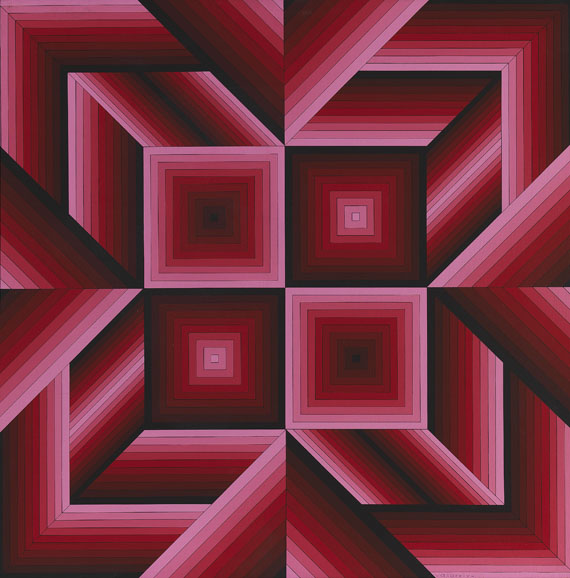280
Victor Vasarely
Saman n° 3313, 1984.
Acrylic on canvas
Estimate:
€ 38,000 / $ 41,800 Sold:
€ 46,360 / $ 50,996 (incl. surcharge)
Saman n° 3313. 1984.
Acrylic on canvas.
Signed lower right. Once more signed and dated on verso, numbered "3313" and titled as well as with dimensions. 78 x 78 cm (30,7 x 30,7 in).
We are grateful to Mr. Pierre Vasarely, sole heir and owner of Victor Vasarely's copyrights, for the oral confirmation of this work's authenticity. The work will be included into the forthcoming catalog raisonné, bwhich is compiled by the Fondation Vasarely, Aix-en-Provence.
Victor Vasarely, whose original name was Gyözö Vásárhelyi, was born in Pécs, Hungary on 9 April 1908. In 1927 Vasarely began his artistic training at a private drawing school in Budapest. One year later he joined the training center 'Mühely' (English 'workshop') which was run by Sándor Bortnyik and taught the ideas of the Bauhaus. After moving to Paris in 1930 Vasarely was successful as a graphic designer and systematically explored the optical and emotional scope of the different graphic techniques.
This made him realize in 1947 that sensation can be caused by geometric means, which can convey new concepts of space, matter and energy. He developed his own geometric abstraction, their variations lead to optic image patterns with kinetic effects. Just as it is the case with this work, the artist arranged geometric forms in lucent colors in a way so that the eye catches the impression of fluctuating movement. Vasarely contributes greatly to the formation of Op-Art and becomes one of its most important representatives.
The decoration of Caracas University in 1954 was the beginning of Vasarely's active support of art in public spaces. He designed murals of metal and ceramic, mainly for buildings in France. He exhibited works regularly at the documenta in Kassel between 1955 and 1968. The official spiral-shaped logo of the 20th Olympic games in Munich was designed by Vasarely. In 1976 the artist founded the Fondation Vasarely in Aix-en-Provence which supported the creation of an institute for contemporary design and architecture in 1981. The Vasarely Museum in the artist's birth-town Pécs was opened in 1976, followed by the opening of a second museum in Zichy Palace in Budapest in 1987. Victor Vasarely died in Paris on 15 March 1997, his foundation had to be closed soon after his death, but the care for the artist's appreciated image world was secured by the refurbishment of Vasarely's estate by his son Pierre [KH].
Acrylic on canvas.
Signed lower right. Once more signed and dated on verso, numbered "3313" and titled as well as with dimensions. 78 x 78 cm (30,7 x 30,7 in).
We are grateful to Mr. Pierre Vasarely, sole heir and owner of Victor Vasarely's copyrights, for the oral confirmation of this work's authenticity. The work will be included into the forthcoming catalog raisonné, bwhich is compiled by the Fondation Vasarely, Aix-en-Provence.
Victor Vasarely, whose original name was Gyözö Vásárhelyi, was born in Pécs, Hungary on 9 April 1908. In 1927 Vasarely began his artistic training at a private drawing school in Budapest. One year later he joined the training center 'Mühely' (English 'workshop') which was run by Sándor Bortnyik and taught the ideas of the Bauhaus. After moving to Paris in 1930 Vasarely was successful as a graphic designer and systematically explored the optical and emotional scope of the different graphic techniques.
This made him realize in 1947 that sensation can be caused by geometric means, which can convey new concepts of space, matter and energy. He developed his own geometric abstraction, their variations lead to optic image patterns with kinetic effects. Just as it is the case with this work, the artist arranged geometric forms in lucent colors in a way so that the eye catches the impression of fluctuating movement. Vasarely contributes greatly to the formation of Op-Art and becomes one of its most important representatives.
The decoration of Caracas University in 1954 was the beginning of Vasarely's active support of art in public spaces. He designed murals of metal and ceramic, mainly for buildings in France. He exhibited works regularly at the documenta in Kassel between 1955 and 1968. The official spiral-shaped logo of the 20th Olympic games in Munich was designed by Vasarely. In 1976 the artist founded the Fondation Vasarely in Aix-en-Provence which supported the creation of an institute for contemporary design and architecture in 1981. The Vasarely Museum in the artist's birth-town Pécs was opened in 1976, followed by the opening of a second museum in Zichy Palace in Budapest in 1987. Victor Vasarely died in Paris on 15 March 1997, his foundation had to be closed soon after his death, but the care for the artist's appreciated image world was secured by the refurbishment of Vasarely's estate by his son Pierre [KH].
280
Victor Vasarely
Saman n° 3313, 1984.
Acrylic on canvas
Estimate:
€ 38,000 / $ 41,800 Sold:
€ 46,360 / $ 50,996 (incl. surcharge)




 Lot 280
Lot 280 
